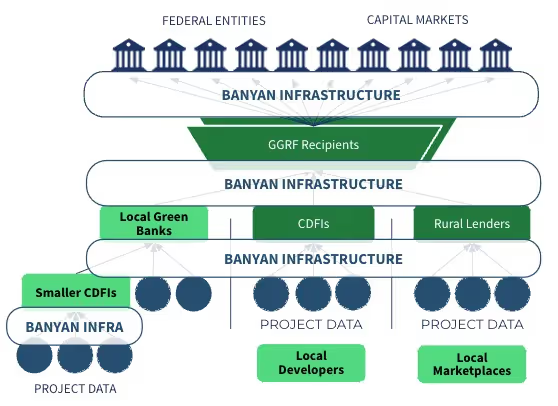Insight Into The Proposed GGRF Accomplishment Reporting Framework

The Greenhouse Gas Reduction Fund (GGRF) is a $27B first-of-its-kind, national-scale program to mobilize government and private capital to address the climate crisis, ensure the United States’ economic competitiveness and promote energy independence while delivering lower energy costs and economic revitalization to communities that have been historically left behind. Awardees of this public capital know that with public funds comes high standards of care, including transparent and meaningful reporting of the disadvantaged communities served, greenhouse gas emission reductions achieved, and private capital mobilized - to name just a few.
Banyan Infrastructure (Banyan) is prepared to be the reporting platform for GGRF Accomplishment Reporting: to provide a technology solution accessible by all GGRF participants to input and aggregate impact, financial, and community data, summarize results, and push meaningful, concise accomplishment reports that are clear, consistent, and comparable over time. Banyan knows how to build SaaS, order and structure data, standardize calculations, and produce timely reports meeting EPA requirements.
However, work still needs to be done to define the right measures and measurement approaches. Our official comment to the EPA can be found here, and a summary of our recommendations is below.
Key Recommendations
Be prescriptive; be specific.
EPA should be specific about the measures it wants to use to assess the GGRF accomplishments across key dimensions: impact, communities served, capital mobilized, greenhouse gas emissions reduced, and aggregate financial measures. Without such, GGRF participants will have to “fill in the blanks” with their interpretation of the final guidance, and these variances will blur our understanding of the outcomes. EPA should define the measurements, methods for calculation, and critical assumptions to use where needed (e.g., grid factors, low-income thresholds, financial metrics). These assumptions are important because doing so will organize participants to deploy capital quickly, and many GGRF sub-recipients - disproportionately bearing the reporting burden for doing the project-level work - will not have the time or resources. Many are small businesses.
Leave Room For Additional Reporting To/From Capital Markets
Ultimately, the entities that deploy GGRF funds will seek to continue their mission even after the last GGRF dollar is deployed. Recapitalization and capital recycling will be needed at higher/aggregate levels to be most efficient. That aggregation of underlying investment data must be easily understood and communicated to capital markets teams to reach institutional and other investors in green bonds, back-leverage facilities, and asset-backed securities. To get there, we must plan now and be ready to present portfolios that clearly articulate risks and achieve diversification. These will require definitions and standards for investment types, technologies, energy off-takers (or savings), guarantees, impacts, etc. See Figure 1 below for a depiction of how Banyan Infrastructure envisions its role in aggregating reporting data.

Prioritize Concrete Definitions and Practical Metrics
Ambiguous terms or overly complex formulas create undue reporting burdens for recipients. The EPA's leadership is vital in providing precise definitions for key metrics like "private capital mobilization," "project types," and "community benefits." This will reduce confusion and ensure consistent reporting, balancing necessary reporting and achievable targets.
Emphasize Clarity Over Complexity in Emissions Accounting
While carbon accounting is crucial, requiring comprehensive Scope 3 emissions reporting for all GGRF recipients poses challenges for smaller organizations because of resourcing/staffing and scale issues. Acknowledging these limitations, the EPA could offer tiered reporting options or initially focus on Scope 1 and 2 emissions where the data is more readily available.
Openness to Technology Solutions
Specialized software can significantly reduce the burden associated with complex reporting. However, there may be challenges regarding scale and the ability to accurately report all required data points for every transaction. The GGRF framework should encourage the use of software, especially cloud-based systems, and provide a list of recommended integrated solutions. Centralized systems facilitate data standardization and streamline analysis for the EPA.
Consult with Market Experts
In creating and updating the reporting framework, the EPA should proactively consult financial intermediaries, project developers, and technology providers experienced in sustainable infrastructure financing. Their practical insights will ensure that the program's requirements are feasible and impactful.
Unlock Potential With Technology
The GGRF has the potential to be an unmatched force for a clean energy future. With careful planning and these recommendations, the EPA, as a critical stakeholder, can ensure its reporting framework serves the goals of accountability and ease of use, maximizing the program's reach and impact.
As a software provider specifically built for green lending, Banyan Infrastructure stands ready to empower financial institutions to maximize their participation in the GGRF. Streamlining processes and unlocking data-driven insights can accelerate the clean energy transition and create a more sustainable future.
To learn more, download the latest white paper from Banyan Infrastructure,“Unleashing the Greenhouse Gas Reduction Fund: How green banks, CDFIs, and community funds can effectively manage funding and efficiently mobilize capital.” Download it here.